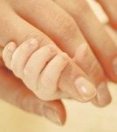Agenesis of the Corpus
Callosum
A birth defect in which there is partial or complete absence of the corpus
callosum (the bundle of nerve fibers that connects the two hemispheres of the
brain).
ACC may occur as an isolated defect, but it is frequently associated with
other malformations, chromosomal abnormalities (trisomy 18 an trisomy 8), and genetic syndromes.
The outcome of the abnormality depends on the underlying cause and the
presence of other structural defects. Isolated ACC (in particular partial ACC) is associated with no or
mild neurologic impairment in a large proportion of cases. ACC occurring as part
of a syndrome may be associated with severe mental retardation and seizures. ACC does not cause
death in the majority of children.
Ultrasound findings include absence of the corpus callosum
and cavum septum pellucidum, 'teardrop' configuration of the lateral ventricles,
dilatation and upward displacement of the third ventricle (interhemispheric
"cyst") , and abnormal branching of the anterior cerebral artery.
Magnetic resonance imaging is sometimes useful in confirming the diagnosis.
Additional abnormalities commonly found in association with ACC include Chiari
malformations, schizencephaly, encephaloceles, Dandy-Walker malformations, holoprosencephaly,
heart defects, and GI or genitourinary malformations.
The risk of recurrence
is ~ 1% for sporadic cases, 25% if ACC is associated with an autosomal
recessive cause, and 50% of males will be affected if inherited as an
X-linked recessive disorder

